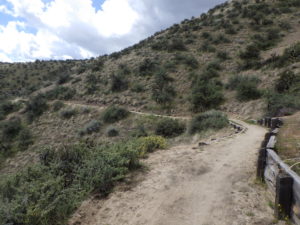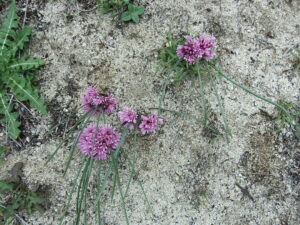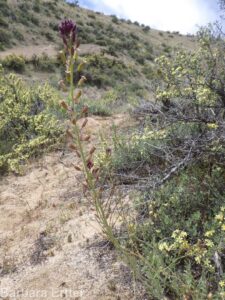POLECAT LOOP WILDFLOWER WALK
late March through April
THIS WALK IS CURRENTLY NOT AN OPTION AS DESCRIBED, DUE TO THE TRAIL NOW BEING PART OF A ONE-WAY LOOP AS PART OF A PILOT PROGRAM BY RIDGE-TO-RIVERS. As so designated, the described section can only be accessed as part of a minimum 4-mile loop. The Pilot Program is scheduled to run through November 1, 2021, after which its continuation will depend on feedback.

Description: This is no longer an easy walk for enjoying a good selection of spring wildflowers, including a diversity of tiny “belly flowers” (best enjoyed at close range). One tiny “treasure” is the elusive, eponymous Idahoa, if only for the name; a challenge to find, and in only one spot along the trail. Other special plants include the rare Aase’s onion (Allium aaseae) and uncommon hairy wild-cabbage (Caulanthus pilosus).
The highlighted walk is the east segment of Polecat Loop Trail (#81) paralleling Cartwright Road. The plant list covers 1.5 miles from the Cartwright Road trailhead to the southern dogleg on the path, with the option of then doubling back (for 3 miles roundtrip), or continuing for loop options with few additional flowers. Most of the recommended section is sandy, but there are stretches with more clay content that should be avoided when muddy. The single-track trail is popular with cyclists, so be alert and courteous.
PLANT LIST [updating needed]
NOTE: Please enjoy the wildflowers and leave them for others to enjoy. Because our unique local flora is already under pressure from invasive weeds and habitat loss, harvesting of native plants is not encouraged on this website, especially along popular trails.
Flowering plants are listed in likely order of occurrence from trailhead; some might not yet be in bloom, or present during a particular year. * designates native plants
BELLY FLOWERS
- *Spring whitlow-grass (Draba verna) – tiny white flowers with notched petals
- *Jagged chickweed (Holosteum umbellata) – inconspicuous non-native
- *Slender phlox (Microsteris gracilis var. humilior)
- *Cross-seed or slender poppercorn-flower (Plagiobothrys tenellus)
- *Miner’s lettuce (probably both Claytonia perfoliata [narrow basal leaves] and C. rubra [diamond-shaped basal leaves])
- *Cleavers, bedstraw, stickywilly, goose-grass (Galium aparine)
- *Desert alyssum (Alyssum desertorum) and/or pale alyssum (Alyssum alyssoides) – widespread non-natives, difficult to tell apart; also called madwort
- *Sand fringepod (Thysanocarpus curvipes)
- *Watson’s cryptantha (Cryptantha watsonii), and possibly weakstem cryptantha (C. flaccida) and/or other Cryptantha spp., most difficult to distinguish
- *Tansymustard (Descurainia longipedicelata)
- *Blue-eyed Mary (Collinsia parviflora)
- *Longhorn plectritis (Plectritis macrocera)
- *Threadleaf phacelia (Phacelia linearis)
- *Fiddleneck (Amsinckia spp.) – species difficult to distinguish
- *Sinuate or rosy gilia (Gilia sinuata)
- *Whitestem blazingstar (Mentzelia albicaulis)
- *Annual or littlebells polemonium (Polemonium micranthum)
- *Idahoa, pepperpod, or scalepod (Idaho scapigera) – “perhaps the most unique and appealing of those members of the mustard family endemic to western North America” (Intermountain Flora)
OTHER WILDFLOWERS IN BLOOM
- *Woolly-pod milkvetch (Astragalus purshii var. glareosus)
- *Bulbous or early woodlandstar/prairiestar (Lithophragma glabrum, previously L. bulbiferum)
- *Narrowleaf or Great Basin biscuitroot (Lomatium simplex, previously included in L. triternatum as ssp. platycarpum, nine-leaf biscuitroot)
- *Sagebrush buttercup (Ranunculus glaberrimus) – can begin blooming in February
- *Foothill or peak saxifrage (Micranthes nidifica, previously in Saxifraga)
- *Pricklyleaf phlox (Phlox aculeata) – intergrading with more diffuse longleaf phlox (Phlox longifolia) in Boise foothills
- *Dwarf or low pussytoes (Antennaria dimorpha)
- *Stork- or cranesbill, filaree (Erodium cicutarium) – non-native
- *Aase’s onion (Allium aaseae) – rare regional endemic, locally abundant on this trail
- *Larkspur (Delphinium sp.) – species difficult to distinguish; some local plants don’t fit existing species descriptions very well
- *Hairy wild-cabbage (Caulanthus pilosus) – uncommon in Boise foothills
- *Arrowleaf balsamroot (Balsamorhiza sagittata)
SHRUBS (not in bloom)
- *Rubber rabbitbrush (Ericameria [formerly Chrysothamnus] nauseosa) — var. hololeuca is the more common larger variety; the smaller, more spindly var. oreophila is mostly on plateaus
- *Big sagebrush (Artemisia tridentata) – most plants are ssp. tridentata, with some sporadic ssp. vaseyana (shorter plants with broader leaves, possibly planted)
- *Bitterbrush, Antelope brush (Purshia tridentata)
- *Netleaf hackberry (Celtis reticulata) – visible on opposite slope across Cartwright Road]
PRIMARY BUNCHGRASSES (mostly not in bloom, but evident)
- *Threeawn grass (Aristida purpurea var. longiseta)
- *Bulbous bluegrass (Poa bulbosa) – weedy non-native
- *Squirreltail grass (Elymus elymoides, previously Sitanion hystrix)
- *Sandberg bluegrass (Poa secunda)
- *Bluebunch wheatgrass (Pseudoroegneria spicata, alternatively in Agropyron or Elymus) – both native-to-site and planted races from other sites probably present
SIGNIFICANT NOXIOUS WEEDS (not in bloom, but evident)
- *Rush skeletonweed (Chondrilla juncea)
- *Medusahead grass (Taeniatherum/Elymus caput-medusae)
- *Cheatgrass (Bromus tectorum) — other annual Bromus also present
- *St. Johnswort, Klamathweed(Hypericum perforatum)



